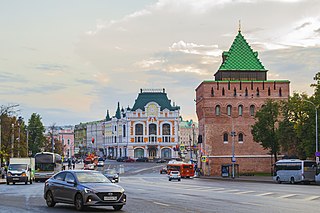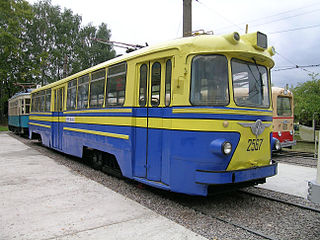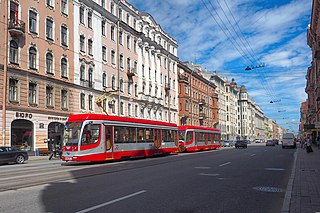
Nizhny Novgorod is the administrative centre of Nizhny Novgorod Oblast and the Volga Federal District in Russia. The city is located at the confluence of the Oka and the Volga rivers in Central Russia, with a population of over 1.2 million residents, up to roughly 1.7 million residents in the urban agglomeration. Nizhny Novgorod is the sixth-largest city in Russia, the second-most populous city on the Volga, as well as the Volga Federal District. It is an important economic, transportation, scientific, educational and cultural centre in Russia and the vast Volga-Vyatka economic region, and the main centre of river tourism in Russia. In the historic part of the city there are many universities, theatres, museums and churches.

The LM-49 is the Soviet motor four-axle tramcar. The first prototype of this vehicle was built in 1949 at the Leningrad Wagon Repair Plant. "LM" means Leningrad Motor tramcar. These tramcars were utilized in Leningrad itself and some other Soviet cities such as Minsk, Gorky, Novokuznetsk and Magnitogorsk. VARZ produced in total 287 LM-49s for Leningrad and 113 for other cities.

MTV-82 is a Soviet four-axle tramcar.

The LM-57 is the Soviet motor four-axle tramcar. First prototype of this vehicle was built in 1957 at the Leningrad Wagon Repair Plant. "LM" means Leningrad Motor tramcar. The VARZ produced nearly 800 LM-57s in 1957–1968.

The ZiU-5 is a Soviet trolleybus model that was built by the Uritsky factory. The ZiU acronym stands for Zavod imeni Uritskogo, which translates as Plant named after Uritskiy. This model of city trolleybus was in mass production from 1959 to 1972. The total number of ZiU-5s produced exceeded 14,500 vehicles. This allowed the ZiU-5 to become dominant model of trolleybus in Soviet towns and cities of that time. The last vehicles were withdrawn from active service in the mid-1980s. The small number of surviving vehicles are kept now for museum purposes.

ZiU-9, or ZIU-9 is a Soviet trolleybus. Other names for the ZiU-9 are ZiU-682 and HTI-682. The ZiU acronym stands for Zavod imeni Uritskogo, which is a factory named after Moisei Uritsky, the Russian revolutionary. Before 1996 this acronym was also a trademark of the vehicle manufacturer Trolza. The ZiU-9 was first built in 1966, although it was only put into mass production in 1972 and it was still assembled along with other more advanced trolleybus vehicles in the Trolza factory until 2015. The total number of produced ZiU-9s exceeds 42,000 vehicles making it the most produced trolleybus in the world. In addition, many copies of ZiU-9 were made in other factories of the former Soviet bloc.

The Kyiv Tram is a tram network that serves the Ukrainian capital Kyiv. The system was the first electric tramway in the former Russian Empire and the fourth one in Europe after the Berlin, Budapest, and Prague tramways. The Kyiv Tram system currently consists of 139.9 km (86.9 mi) of the track, including 14 km (8.7 mi) of two Rapid Tram lines, served by 21 routes with the use of 523 tram cars. However, the system is being neglected, the serviced track length is decreasing at a fast rate and is replaced by buses and trolleybuses.

LVS-86 is a model of tramcar developed at the Leningrad Tram Manufacturing Plant in the former Soviet Union. LVS stands for "Leningrad-made articulated tram" in Russian, and 86 refers to the model year. The design was based on the LVS-80 tramcar. 473 LVS-86s were built from 1987 until 1997. LVS-86s currently run in Saint Petersburg and formerly in Arkhangelsk. Tram operation in Arkhangelsk ceased in July 2004.

The Kirov Plant, Kirov Factory or Leningrad Kirov Plant (LKZ) is a major Russian mechanical engineering and agricultural machinery manufacturing plant in St. Petersburg, Russia. It was established in 1789, then moved to its present site in 1801 as a foundry for cannonballs. The Kirov Plant is sometimes confused with another Leningrad heavy weapons manufacturer, Factory No. 185 . Recently the main production of the company is Kirovets heavy tractors.
Petersburg Tram Mechanical Factory (PTMF) was one of the leading manufacturers of tramcars in Russia and the CIS-countries located in Saint Petersburg. Until 1981 it was the only enterprise in the USSR having tram manufacturing as its core business, The plant was the sole supplier of rolling stock for the tram system of Leningrad, once largest metropolitan tram system in the world.

The LM-33 is a four-axle Soviet tram, produced by the Petersburg Tram Mechanical Factory (PTMF) from 1933 to 1939.

The Rohrbach Ro V Rocco was a twin-engined seaplane that was designed and manufactured by the German aircraft manufacturer Rohrbach Metall-Flugzeugbau.

The Ust-Katav Wagon-Building Plant, officially the Ust-Katavskiy Carriage Works named after S. M. Kirov is a railroad carriage works in Ust-Katav, Chelyabinsk Oblast, Russia.

The production of urban electric transport is a branch of Russian engineering. Russia has the largest number of trolley (85) and tram systems (86) in the world.

The Nizhny Novgorod tram network comprises 16 tramlines and uses a standard Russian broad gauge. Trams have been operating in Nizhny Novgorod since 1896, but services were interrupted for a few years following the 1917 Russian Revolution.

PC Transport Systems LLC is a Russian company specializing in the production of urban electric vehicles: trams, trolleybuses and electric buses.

The KTM-5, later known as the 71-605, is a Soviet tram model manufactured by UKVZ. First introduced in 1963, the KTM-5 was mass-produced between 1969 and 1992, with a total of 14,991 tramcars being made. KTM-5 trams were built exclusively for the Soviet Union, and therefore are currently only operating in post-Soviet states.

The 71-623 is a 40% low floor, one way tram built by Ust-Katav Wagon-Building Plant. Construction completed in November 2008, under the contract to Mosgortrans which was created in January 2008. Since then, it has been exported to Kazakhstan, Ukraine and Latvia.

The 71-628 is a Russian fully low-floor tram model built by Ust-Katav Wagon-Building Plant since 2020. The tram is based on the unrealised 71-625 project and is a development of the partially low-floor 71-623 tram.





















